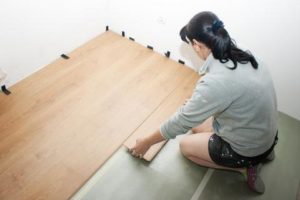Laminate flooring is a great option for any home, especially those that are active with children and pets. As with any product category there are varying degrees of quality. Thickness, AC Rating for wear surface, locking system and texture are just some of the factors that play a part in the quality of your floor. Regardless of the different options, it is an excellent value product that can allow you to significantly enhance the appearance of any room. So after you’ve done all your research, found that perfect visual, and purchased your product… it’s time for installation.
Laminate flooring is DIY friendly. However, we’re not all qualified to install it. After speaking with several independent flooring inspectors over the past several years, I’ve found that roughly 99% of laminate flooring failure claims are installation related. Even the most experienced installers occasionally make mistakes, cut corners or fail to read the installation instructions correctly. Unfortunately, this leads to problems, frustration and expenses down the road. Whether you’re going to attempt to install the product yourself or have found a professional installer, make sure whoever takes on the project follows the manufacturer’s instructions! (Tip: they come inside every box)
Below are the 6 most common mistakes that lead to these laminate floor failures. Make sure to keep these in mind when discussing your job with the installer.
1. Site Conditions – ensure the temperature, humidity, and subfloor requirements (flatness, moisture, joist spacing, etc.) listed in the installation instructions are followed.
2. Acclimation – it is a common misnomer that laminate flooring does not need to acclimate to its new environment. Typically, laminates require 48-72 hours to acclimate depending on the product.
3. Expansion Gap – installation of laminate flooring will call for a 5/16”-3/8” expansion space along the perimeter of the room. This may be the most common source of problems, as this gap is either too small or not included at all. It should not only occur along the walls, but also up against stairs, around corners and/or other vertical surfaces in the home. As the product expands due to temperature change, it will create “pinch points” that will lead to product failure.

4. Expansion Joint – as laminate flooring expands, the locking system can only handle so much pressure. The larger the space, the greater the pressure. For this reason, laminate installation requires an expansion joint, called a “T-mold”, which alleviates that pressure. Individual products have different room size requirements. Many installers fail to realize that length can continue into hallways and other open floor plan rooms. Anywhere the laminate continuously runs must be factored into that particular room size.
5. Locking System – there are different methods for installing different locking systems. Failure to install laminate according to the instructions for the particular locking system being used can cause the lock to not fully engage or create damage to planks, such as, “chipping” of the edges. Some require tap blocks, some require the installer to tap in the product at a particular angle, and some are as simple as just dropping the plank into place. Make sure the proper method is being used.


